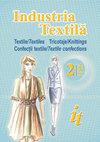烧伤治疗用纺织品结构——弹性和抗菌性能的表征
IF 0.9
4区 工程技术
Q3 MATERIALS SCIENCE, TEXTILES
引用次数: 0
摘要
本文展示了织物结构(第一层和第三层)的弹性和抗菌特性,它们组成了具有明确特征的三层复合材料,旨在治疗人类烧伤。用活性物质:胶原蛋白、胶体银、CMC、粘土、透明质酸、聚氨酯等对通过编织(5种变体)和交织(3种变体)获得的织物结构进行进一步处理。通过使用专用软件计算弹性模量和各向异性变量的基本统计指标:平均值、分散度和标准偏差,不对称的中位数和四分位数、偏度和峰度,并强调应进行干预的情况。获得了弹性模量和各向异性变量的直方图和箱形图。对于具有不同各向异性水平的功能化织物结构,通过测定微生物种群的对数和百分比减少来评估对革兰氏阳性微生物(金黄色葡萄球菌ATCC 6538)和革兰氏阴性微生物(大肠杆菌ATCC 8739)以及白色念珠菌ATCC 10231的抗菌活性。通过评价溶血指数(ASTM F756-13)来测定血液相容性。所获得的结果导致了多层矩阵的结构组合的定义。本文章由计算机程序翻译,如有差异,请以英文原文为准。
Textile structures for the treatment of burn wounds – characterization
of elastic and antibacterial properties
The paper shows the elastic and antibacterial features of the textile structures (Layer I and III) which make up a
three-layer composite material with well-defined features, aimed at the treatment of human burns. The textile structures
obtained through weaving (5 variants) and interweaving (3 variants) were further treated with active substances:
collagen, colloidal silver, CMC, clay, hyaluronic acid, polyurethane, etc. By using specialized software, fundamental
statistical indicators were calculated for the modulus of elasticity and anisotropy variables: mean, dispersion and
standard deviation, median and quartiles, skewness, and kurtosis for asymmetry and highlighting the cases in which
interventions should be carried out. The histograms and box-plot graphs of the modulus of elasticity and anisotropy
variables were obtained. For the functionalized textile structures, with different levels of anisotropy, the antibacterial
activity was evaluated on Gram-positive microorganisms (Staphylococcus aureus ATCC 6538) and Gram-negative
(Escherichia coli ATCC 8739) and Candida albicans, variety ATCC 10231 by determining the logarithmic and percentage
reduction of microorganism populations. The hemocompatibility was determined by evaluating the hemolytic index
(ASTM F756-13). The results obtained led to the definition of the combinations of structures of the multilayer matrix.
求助全文
通过发布文献求助,成功后即可免费获取论文全文。
去求助
来源期刊

Industria Textila
工程技术-材料科学:纺织
CiteScore
1.80
自引率
14.30%
发文量
81
审稿时长
3.5 months
期刊介绍:
Industria Textila journal is addressed to university and research specialists, to companies active in the textiles and clothing sector and to the related sectors users of textile products with a technical purpose.
 求助内容:
求助内容: 应助结果提醒方式:
应助结果提醒方式:


